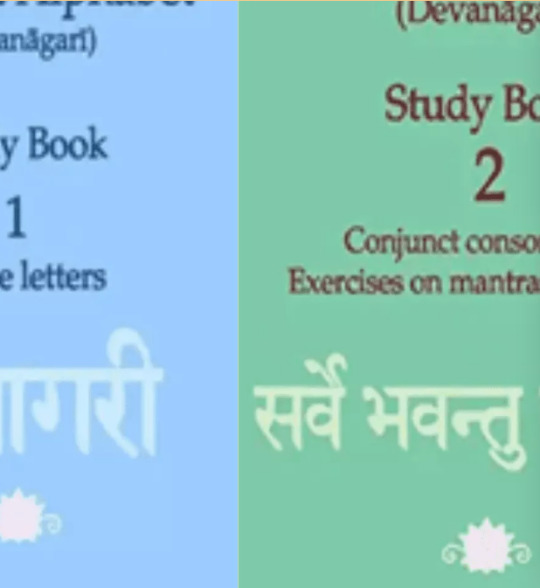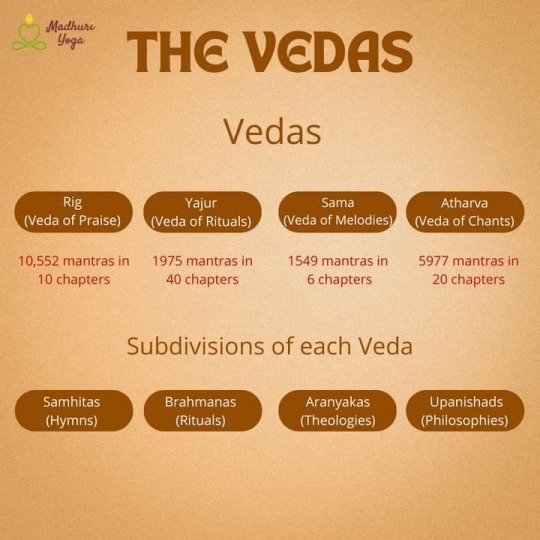#sanskrit language
Text
The Indian Brahmins took the memorization of the Vedas very seriously, and developed means to ensure accuracy and the careful reproduction of the same words and sounds from generation to generation. Careful, even exact oral replication of the Vedas was part of the Hindu faith, institutionalized during the learning process and maintained through peer observation and pressure through the life of a Brahmin. This community of faithful Brahmins was large and they all went through the same learning process, which was standardized to some degree. Deviation from the ... path of exact replication would have brought powerful forces of censure to bear on the offender...
The noted Sanskritist J.A.B van Buitenen told me that in the eighteenth and nineteenth centuries the Europeans who were learning Sanskrit were impressed by the fact that no matter where they went in the subcontinent, when they heard Brahmins recite the Vedas they heard the exact same thing. From Peshawar to Pondicherry, or Calcutta to Cape Comorin, hundreds of thousands, even millions, of Brahmins who had no direct contact knew these texts in precisely the same way...
— Gregory L. Possehl, Indus Age: The Beginnings
#hinduism#hindu#sanskrit#sanskrit language#brahmin#brahmins#indian brahmins#hindu brahmins#priesthood#priest#ancient india#india#memory#religion
11 notes
·
View notes
Text
Exploring Language Courses at an Esteemed Institute
In a world that is becoming increasingly interconnected, being able to speak multiple languages is a highly valuable asset. Students at a well-known institution focused on enhancing language skills explore a variety of language courses on a journey of discovery. In this piece, we examine the Sanskrit Language Course and Hindi language courses available at this prestigious institution, looking at how they meet the increasing need for learning new languages.
Sanskrit Language Course:
Steeped in history and revered for its classical significance, Sanskrit is a language that holds immense cultural importance. The Sanskrit Language Course at the institute is designed to provide students with a deep understanding of this ancient language, enabling them to explore its rich literary heritage.
The curriculum of the Sanskrit Language Course is comprehensive, covering aspects such as grammar, vocabulary, and script. Through a combination of classroom instruction, interactive exercises, and practical application, students develop proficiency in reading, writing, and speaking Sanskrit.
One of the highlights of the Sanskrit Language Course is its focus on cultural immersion. Students not only learn the language but also gain insights into the philosophical and religious traditions associated with Sanskrit literature. By delving into ancient texts and exploring their meanings, students develop a profound appreciation for the linguistic and cultural legacy of Sanskrit.
Bridging Cultures Through Communication
As one of the most widely spoken languages in the world, Hindi plays a vital role in connecting people across diverse communities. The institute offers a range of Hindi language courses tailored to suit different proficiency levels, from beginners to advanced learners.
The curriculum of the Hindi language courses covers essential language skills such as reading, writing, listening, and speaking. Through interactive sessions, language labs, and real-world scenarios, students acquire practical language proficiency that enables them to navigate various social and professional contexts.
In addition to language skills, the Hindi language courses also incorporate cultural elements, allowing students to gain a deeper understanding of Indian customs, traditions, and societal norms. Through cultural events, language clubs, and community engagement initiatives, students have the opportunity to immerse themselves in the vibrant tapestry of Hindi-speaking cultures.
Nurturing Linguistic Talent for a Globalized World
In conclusion, the institute stands as a beacon of linguistic excellence, offering a range of language courses that cater to diverse interests and goals. Whether one is drawn to the ancient wisdom of Sanskrit or the contemporary relevance of Hindi, the institute provides a supportive environment for language learning and cultural exploration.
Enrolling in the Sanskrit Language Course or Hindi language courses at the institute is not just an educational endeavor; it is a journey of personal growth and cultural enrichment. As the world continues to become increasingly interconnected, the institute remains committed to nurturing linguistic talent and fostering a deeper appreciation for language and culture.
0 notes
Text
Observing World Sanskrit Day: Protecting an Old Legacy
World Sanskrit Day is a valued event that resounds with the reverberations of an old phonetic fortune – the Sanskrit language. This day respects the rich legacy, significant insight, and social importance epitomized inside the Sanskrit script. In this far reaching article, we plunge profound into the meaning of World Sanskrit Day, its verifiable roots, the immortal significance of Sanskrit, its…

View On WordPress
#Ancient scripts#Cultural significance#Language preservation#Linguistic heritage#Sanskrit language#Sanskrit literature#Vedic traditions
0 notes
Text
Sanskrit Mein Ginti
Sanskrit Mein Ginti: संस्कृत हमारे पुराणों की भाषा है। हर भाषा में यह इसकी नींव के रूप में है। छात्रों को कई परीक्षाओं में संख्याएं संस्कृत में लिखनी चाहिए। इसकी विशेषज्ञता जरूरी है। विश्व की सबसे प्राचीन भाषा संस्कृत को कहा जाता है। ईश्वरवादी भारतीय इसे "देवभाषा" के रूप में संदर्भित करते हैं क्योंकि उन्हें लगता है कि यह एक भाषा या भाषण है जो सीधे भगवान के मुख से आता है। सं+सुत+कृ+कत से संस्कृत शब्द बनता है। 'प्राकृतिक भाषा की खेती' का अनुवाद कैसे किया जाता है।
0 notes
Text
Welcome to the Godhuli Group Archives, your destination forBEST GODHULI SANSKRIT QUOTES T-SHIRT. Embrace timeless phrases, ancient proverbs, and spiritual teachings imprinted on premium fabric. Experience the fusion of style and culture with our Sanskrit quotation T-shirts. Discover the power of words today.
1 note
·
View note
Text
Discover the Beauty of Devanagari: Learn Sanskrit and Hindi at HUA

INTRODUCING DEVANAGARII
This course is targeted at all students who are beginners of Sanskrit, Hindi, or one of the other languages of India that use DevanAgari script. The focus is on learning the alphabets and combination letters in the two most popular and important languages of India, Sanskrit and Hindi. This course is the basic course for all the students who do not have any background knowledge of Devanagari script.
Introducing DevanAgarii Course Description:
There is a great joy associated with mastering a new language, regardless of what that language is. Every new word acquired gives rise to a new sense of accomplishment. For example, the joy of learning the Sanskrit language is multi-fold, because it provides direct access to the master-key of the living Hindu Civilization, to the texts and narratives of its rich traditions of dharma, yoga, jnana, art, music, dance, song, and the various cultural and spiritual traditions.
This course will enable students to access the vast corpus of Sanskrit and Hindi Texts directly and is a foundational course for students of all ages and backgrounds from Middle School onwards.
It is a stand-alone course offered by the Hindu University of America, having 15 hours of instruction in English over a 10-week period (one quarter at the HUA). It is targeted at all students who are real beginners of Sanskrit, Hindi, or one of the other languages of India that use DevanAgari script. The focus is on learning the alphabets and script. The focus is on learning the alphabets and script. The focus is on learning the alphabets and script. The focus is on learning the alphabets and d combination letters in the two most popular and important languages of India, Sanskrit and Hindi.
There will be two homework assignments and no quarter-end-exam for this course. On completion, students will get 1.5 credits. More importantly, they will be ready to delve into a deeper study of either of these great languages that inform and enliven a civilization and culture, its wisdom and worldview, its philosophy and spirituality, through the other Certificate Programs offered by the HUA.
Course Contents:
Study and use of the DevanAgari script,
Origin of the sounds, Pronunciations of Vowels and Consonants
Combination letters as applicable to Hindi and Sanskrit.
Learning Objectives:
Understand the origin of various sounds in DevanAgarii.
Pronounce and write the alphabets that are single letters, both vowels, and consonants.
Pronounce and write combination letters.
Get personal coaching in pronouncing a few basic words in Hindi and Sanskrit.
At the completion of this course, students will have the option to take up further advanced studies in Sanskrit through:
(a) the Certificate Program in Sanskrit Proficiency (CPSP), or
(b) the Certificate Program in Shuddh (Pristine) Hindi (CPSH), or
(c) Any other Certificate Program to be offered by the HUA in future in many Indic languages that use the DevanAgari script.
CONTACT — 407–205–2118
Overview >> Hindu University Of America
EMAIL- [email protected]
Address- 5200 Vineland Rd 125 Orlando, FL 32811
0 notes
Text
Learn Bhagavad Gita (Chapter 2) and Basics of Sanskrit Language - HUA
This course is the third in a 16-course sequence which constitutes the Certificate Program in Bhagavad Geeta through Samskritam. In this Course, students will be introduced to both the Bhagavad Geeta (Chapter 2) and simple Samskritam.
This course is the part of the program-Certificate Program in Bhagavad Geeta through Sanskrit– Beginner Phase.
Learn Bhagavad Geeta (Ch. 2) and simple Samskritam
Course Description:
In this Course, students will be introduced to both the Bhagavad Geeta (Chapter 2) and simple Samskritam. Elementary structures of the Sanskrit language will be illustrated through the verses of the Bhagavad Geeta. Students will gain familiarity with the script, and rapidly expand their vocabulary. Using special handouts, each verse of the Bhagavad Geeta will be expounded to unravel both the meaning of the verse and the structure of the language. Students will learn to think about the Bhagavad Geeta from within the Sanskrit language, and the worldview that it represents.
Course Content:
This course is the 3rd in a 16-course sequence which constitutes the Certificate Program in Bhagavad Geeta through Samskritam. In this course, the faculty will lead the students verse by verse, in sequence through the Bhagavad Geeta, while simultaneously unfolding both the meanings of the verses in Chapter 2 as well as the nuances of the language. This course will also introduce students to the following elements of the Sanskrit language: noun, consonant, and case endings, adjectives, adverbs, pronouns, different verb types and usages, direct, indirect, and conditional speech, all illustrated using sentence formation and structure found in the Bhagavad Geeta.
Learning Objectives:
In this course, students will be able to relate to words and expressions from the Bhagavad Geeta in the following areas:
Further imbibe building blocks of the language through everyday conversation.
Understand the use of the 3rd, 4th, 5th, 7th, and vocative case-endings.
Continue practicing more with verbal roots (dhatu) and their different forms, tenses.

CONTACT — 407–205–2118
Overview >> Hindu University Of America
EMAIL- [email protected]
Address- 5200 Vineland Rd 125 Orlando, FL 32811
Know More
0 notes
Text
संस्कृत भाषामा आकर्षण
संस्थागत विद्यालयमा संस्कृत पढाउने क्रम बढ्न थालेको छ । अङ्ग्रेजी माध्यममा पढाइ हुने विद्यालयमा विद्यार्थी नेपालीमा कमजोर हुन थालेपछि सुधारका लागि संस्कृत भाषाको पठनपाठन गराउने क्रम बढेको हो ।
संस्थागत विद्यालयमा संस्कृत पढाउने क्रम बढ्न थालेको छ । अङ्ग्रेजी माध्यममा पढाइ हुने विद्यालयमा विद्यार्थी नेपालीमा कमजोर हुन थालेपछि सुधारका लागि संस्कृत भाषाको पठनपाठन गराउने क्रम बढेको हो ।
विगत पाँच वर्षदेखि विभिन्न विद्यालयमा संस्कृत विषयका अध्यापन गर्दै आउनुभएका शिक्षक योगराज सापकोटा संस्थागत विद्यालयमा संस्कृत विषय पढाउने शिक्षककोे खोजी भइरहेको बताउनुहुन्छ । संस्कृतिसँग जोडिएको विषय…

View On WordPress
0 notes
Link

“A 27-year-old PhD scholar finally cracked the riddle which has defeated Sanskrit experts since the 5th Century BC—by decoding a rule taught by “the father of linguistics” Pāṇini.
The discovery makes it possible to ‘derive’ any Sanskrit word—to construct millions of grammatically correct words including ‘mantra’ and ‘guru’—using Pāṇini’s revered ‘language machine’ which is widely considered to be one of the great intellectual achievements in history.
Leading Sanskrit scholars have described the discovery as ‘revolutionary’—and it now means that Pāṇini’s grammar can be taught to computers for the first time...
Pāṇini’s system—4,000 rules detailed in his greatest work, the Aṣṭādhyāyī which is thought to have been written around 500 BC—is meant to work like a machine. Feed in the base and suffix of a word and it should turn them into grammatically correct words and sentences through a step-by-step process.
However, until now, there had been a huge problem. Scientists say that, often, two or more of Pāṇini’s rules are simultaneously applicable at the same step, leaving scholars to agonize over which one to choose...
Thought to have lived in a region in what is now north-west Pakistan and south-east Afghanistan, Pāṇini taught a ‘metarule’ to help decide which rule should be applied in the event of a conflict...
Traditionally, scientists have interpreted Pāṇini’s metarule as meaning: in the event of a conflict between two rules of equal strength, the rule that comes later in the grammar’s serial order wins.
Rajpopat rejects this, arguing instead that Pāṇini meant that between rules applicable to the left and right sides of a word respectively. Pāṇini wanted us to choose the rule applicable to the right side. Employing this interpretation, Rajpopat found Pāṇini’s language machine produced grammatically correct words with almost no exceptions...
“This discovery will revolutionize the study of Sanskrit at a time when interest in the language is on the rise.”
Sanskrit is an ancient and classical Indo-European language from South Asia. It is the sacred language of Hinduism, but also the medium through which much of India’s greatest science, philosophy, poetry, and other secular literature have been communicated for centuries.
While only spoken in India by an estimated 25,000 people today, Sanskrit has influenced many other languages and cultures around the world.
Rajpopat, who was born in Mumbai and learned Sanskrit in high school, explained, “Some of the most ancient wisdom of India has been produced in Sanskrit and we still don’t fully understand what our ancestors achieved.
“I hope this discovery will infuse students in India with confidence, pride, and hope that they too can achieve great things.”
He said that a major implication of his discovery is that now we have the algorithm that runs Pāṇini’s grammar, we could potentially teach this grammar to computers.
“Computer scientists working on Natural language processing gave up on rule-based approaches over 50 years ago. So teaching computers how to combine the speaker’s intention with Pāṇini’s rule-based grammar to produce human speech would be a major milestone in the history of human interaction with machines, as well as in India’s intellectual history.”” -via Good News Network, 12/16/22
2K notes
·
View notes
Text
About Vedic Scriptures



#vedic literature#hinduism#hindublr#sanatan dharma#ancient india#vedic culture#mantra#bharat#ancient indian history#puranas#sanskrit#languages#krishna#dharma#karma#hindu culture
171 notes
·
View notes
Text
Exploring the Beauty of Sanskrit and Hindi
In a world where communication knows no boundaries, the mastery of languages opens doors to diverse cultures, enriching experiences, and boundless opportunities. At the forefront of language education stands the Symbiosis Institute of Foreign and Indian Language (SIFIL), a distinguished institution dedicated to nurturing linguistic proficiency and cultural understanding.
Offering a spectrum of courses tailored to meet the evolving demands of the global landscape, SIFIL empowers students to embark on a transformative journey of language exploration. Let's delve into the enriching offerings of SIFIL, with a spotlight on its Sanskrit language course and Hindi language courses.
Sanskrit Language Course: Reviving an Ancient Heritage
Steeped in history and revered for its timeless wisdom, Sanskrit holds a unique place in the linguistic tapestry of India. Renowned as the language of ancient scriptures, philosophical treatises, and classical literature, Sanskrit embodies the rich cultural heritage of the Indian subcontinent. Recognizing the significance of preserving this linguistic legacy, SIFIL offers a comprehensive Sanskrit language course designed to cater to both beginners and advanced learners.
Through a blend of interactive classroom sessions, experiential learning activities, and scholarly guidance, students embark on a journey to unravel the nuances of Sanskrit grammar, vocabulary, and literary texts. Whether aspiring to delve into the depths of Vedic literature, explore the intricacies of Sanskrit poetry, or gain proficiency for academic pursuits, SIFIL's Sanskrit language course provides a holistic learning experience rooted in tradition and innovation.
Hindi Language Courses: Bridging Cultures and Communities
As one of the most widely spoken languages in the world, Hindi serves as a vital link connecting diverse communities across India and beyond. With its rich literary tradition, cultural significance, and widespread usage in various domains, proficiency in Hindi opens up a plethora of opportunities for individuals seeking to engage with the vibrant tapestry of Indian society. At SIFIL, learners can immerse themselves in the beauty of Hindi language and literature through specialized courses tailored to suit different proficiency levels and learning objectives.
Whether aiming to enhance conversational skills, delve into Hindi literature, or prepare for competitive examinations, SIFIL's Hindi language courses offer a structured curriculum delivered by experienced faculty members passionate about promoting linguistic excellence. Through interactive sessions, audio-visual aids, and cultural immersion activities, students not only develop linguistic fluency but also gain insights into the rich cultural heritage and linguistic diversity of India.
Why Choose SIFIL for Language Education?
Expert Faculty: SIFIL boasts a team of seasoned faculty members with expertise in language teaching and research, ensuring high-quality education delivery.
Holistic Approach: The institute adopts a holistic approach to language learning, incorporating diverse pedagogical methods, cultural immersion experiences, and academic rigor to foster comprehensive language proficiency.
Flexible Learning Options: SIFIL offers flexible course schedules, including weekday and weekend batches, as well as online learning modules, catering to the diverse needs of students.
Industry-Relevant Curriculum: The institute's curriculum is designed to align with industry standards and evolving linguistic trends, equipping students with practical skills and knowledge applicable in real-world contexts.
Collaborative Learning Environment: SIFIL fosters a supportive and collaborative learning environment, where students engage in peer-to-peer interactions, cultural exchanges, and collaborative projects, enhancing their overall learning experience.
Embark on Your Language Journey with SIFIL
Whether you aspire to explore the depths of Sanskrit literature, communicate fluently in Hindi, or embark on a multilingual odyssey, SIFIL provides the perfect platform to realize your linguistic aspirations. With its diverse range of courses, including the Sanskrit language course and Hindi language courses, SIFIL empowers learners to unlock the doors to cultural richness, linguistic diversity, and global connectivity.
Join SIFIL today and embark on a transformative journey of language learning and cultural discovery.
0 notes
Text

Sun, the word for the blinding nuclear fusion reactor in the sky, stems from the same Proto-Indo-European word as French soleil, Swedish sol, Welsh haul, Irish súil, and Ancient Greek hēlios, whence the prefix helio-. They grew apart by the ravages of time. Here's how.
#historical linguistics#linguistics#language#etymology#lingblr#sanskrit#celtic languages#romance languages#germanic languages#ancient greek
323 notes
·
View notes
Text



I love Taylor's "Can I go where you go? Can we always be this close?" BUT these are ✨ DIVINE✨"hothon se chu lo tum, mera geet amar kar do, ban jao preet meri, meri jeet amar kar do" touch my soul (me) with your lips, make my song immortal, become my love, make my victory immortal and "bin puche mera naam aur pata, rasmon ko rakh ke pare, char kadam bas char kadam, chaldo na saath mere" without asking me my name or my address, keeping the customs and traditions away, four steps, just four steps, walk with me please and "janam janam janam saath chalna yuhi, kasam tumhe kasam aake milna yahin, ek jaan hai bhale do badan ho juda, meri hoke hamesha hi rehna, kabhi na kehna alvida" lives, all my lives, walk with me like this, give me your promise to come and meet me like this, there's one soul among us even if our bodies are apart, stay mine forever, don't ever say goodbye and "barkha, bijli, baadal jhoothe, jhoothi phoolon ki saugatein, sacchi tu hai, sachha main huin, sacchi apne dil ki baatein" the rain, the thunder, the clouds are all liars, there are lies in the gifts of all the flowers, only you are true, and so are the conversations of our hearts



Hindi is the language of love and promise (2)
#india#desi dark academia#indian academia#sanskrit#indian aesthetic#indian poets#desi women#indian girl#south asian#scholary academia#desi music#desi academia#desi aesthetic#love language#Hindi#hindi academia#हिन्दी#Hindi is the language of love
159 notes
·
View notes
Text
candy
late 13c., "crystallized sugar," from Old French çucre candi "sugar candy," ultimately from Arabic qandi, from Persian qand "cane sugar," probably from Sanskrit khanda "piece (of sugar)," perhaps from Dravidian (compare Tamil kantu "candy," kattu "to harden, condense").
25 notes
·
View notes
Text
*gno-
*gnō-, Proto-Indo-European root meaning "to know."
It forms all or part of: acknowledge; acquaint; agnostic; anagnorisis; astrognosy; can (v.1) "have power to, be able;" cognition; cognizance; con (n.2) "study;" connoisseur; could; couth; cunning; diagnosis; ennoble; gnome; (n.2) "short, pithy statement of general truth;" gnomic; gnomon; gnosis; gnostic; Gnostic; ignoble; ignorant; ignore; incognito; ken (n.1) "cognizance, intellectual view;" kenning; kith; know; knowledge; narrate; narration; nobility; noble; notice; notify; notion; notorious; physiognomy; prognosis; quaint; recognize; reconnaissance; reconnoiter; uncouth; Zend.
It is the hypothetical source of/evidence for its existence is provided by: Sanskrit jna- "know;" Avestan zainti- "knowledge," Old Persian xšnasatiy "he shall know;" Old Church Slavonic znati "recognizes," Russian znat "to know;" Latin gnoscere "get to know," nobilis "known, famous, noble;" Greek gignōskein "to know," gnōtos "known," gnōsis "knowledge, inquiry;" Old Irish gnath "known;" German kennen "to know," Gothic kannjan "to make known."
—Etymonline
#etymology#knowing#knowledge#know#language#linguistics#Proto-Indo-European#Sanskrit#Persian#Latin#Greek#Irish#German#quote#gnosis
54 notes
·
View notes
Text
Get Fluent in Sanskrit: Intermediate Phase with Samskrita Bharati USA

The Intermediate Phase of the Certificate Program in Sanskrit Proficiency is a 1-year course made up of 4 quarters, each worth 1.5 credit hours. It prepares students who already have some knowledge of Sanskrit to read, write, and have simple conversations. The course is taught in English and is accessible to people worldwide. The program includes four courses: Learn Sanskrit - Stories & Songs, Learn Sanskrit - Words and Phrases, Learn Sanskrit - Vocabulary & Structure, and Learn Sanskrit - Nouns and Declensions.
The course is aimed at high school students and adults who want to learn Sanskrit in-depth to use it while studying Hinduism's texts and literature and related knowledge systems. The course is taught by dedicated HUA Faculty members using a user-friendly Online Platform with live virtual classrooms.
During the course, students will learn how to write and read the Sanskrit script DevanAgari, create straightforward stories and songs, recognize common Sanskrit words and phrases, learn basic structures, expand their vocabulary, and develop the ability to use moderately complex expressions. The program is structured using the curriculum and textbooks designed by Samskrita Bharati USA (SBusa.org), including "SUSHAMA" and "MUKULAM," along with other appropriate course content.
Upon completion of the Intermediate Phase, students can move on to the advanced phase of the Certificate Program in Sanskrit Proficiency, which lasts for 8 quarters or 88 weeks.
CONTACT — 407–205–2118
Overview >> Hindu University Of America
EMAIL- [email protected]
Address- 5200 Vineland Rd 125 Orlando, FL 32811
0 notes